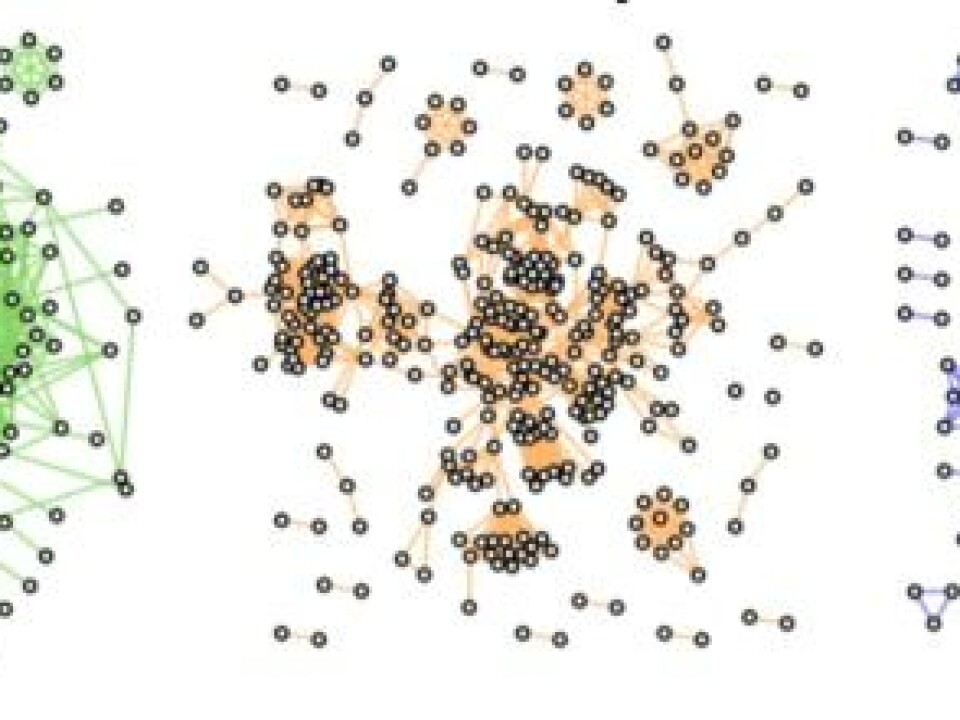
Mathematicians can now predict your social networks
A team of mathematicians have developed a formula to predict how people meet. The results could help scientists understand how diseases are transmitted.
Mathematicians have developed a formula that can describe our interactions with the people around us.
The discovery could improve models to predict human behaviour, which can improve our understanding of how epidemics spread or improve town planning.
“For the first time in history, we can now study social networks on a large scale and learn more about them,” says co-author Sune Lehmann from the Department of Applied Mathematics and Computer Science at the Technical University of Denmark (DTU).
“Until now, no one had really gotten down to the mathematical core of it--but now we have, and it opens up for new modelling options,” he says.

The results are published in the scientific journal PNAS.
Thousands of articles on social networks
We all take part in social networks. It could be in a football club, at the work place, meeting old school friends, and so on.
There are many reasons why scientists want to understand the mathematics behind social behaviour. For example, by understanding patterns of behaviour, scientists can understand how quickly infections can be transmitted and ultimately how epidemics spread.
But until now, maths had fallen short of being able to describe these complex networks.
To change that, Lehmann devised an experiment involving 1,000 undergraduate freshmen from the Technical University of Denmark.
They all received a mobile phone, which tracked their whereabouts for 2.5 years. Even more, it recorded who the students spoke to, who they socialised with on Facebook, and who they met out in the real word.
See how students whereabouts were tracked for 2.5 years (Video: Ulf Aslak Jensen)
All of this was possible with the telephones inbuilt apps, GPS, and Bluetooth.
Lehmann and his team amassed a gigantic dataset, which contained data on all of the students’ social interactions.
“The idea was to see if we could learn something from looking at all of these data channels simultaneously, and not just what people did on Facebook, or who they spoke with on the phone,” says Lehmann. “We have all of this in the dataset alongside data on when people met each other face to face.”
Read More: Does social media help us work smarter?
Time is important
Using all of this data, Lehmann and colleagues were able to mathematically describe the students’ social network dynamics.
They discovered that time resolution of the data was an important factor to understand the complex networks.
Without this temporal framework, the data becomes a mass of social interactions, which does not yield much useful information. So the scientists broke the data up into 15 minute time intervals.
In doing so, they could see how one person interacts with their friends at a given time of the day, without having to analyse everyone’s social connections at the same time.
“It’s been a hard nut to crack because we were studying the entire network over long time intervals. So the picture was too muddy. We find that you don’t need to search after all these groups in the entire network. If you just look at the data in short snippets of 15 minutes, then it all falls into place, and you can observe the groups directly,” says Lehmann.
The results also show how each individual student forms a part of different social groups.
It could be specific courses, reading groups, pub meet ups, or sports teams. Often these groups overlap with one another.
Read More: Older people think social media is superficial
How social networks function
Lehmann and his colleagues split up the social networks into small sections to make it easier to model.
“In reality we’re now at the point where we can start to take all of the small study groups and build entire social networks out of them,” says Lehmann.
These interactions are called “gatherings” and describe a meeting between people that last for more than five minutes and are assumed to be between people who know each other, and not just random encounters on campus.
By comparing all of these gatherings, the scientists can begin to identify what precedes a meeting, which could be a phone call, text message, or Facebook.
They can also see how the social groups change over time as people join or leave the group.
“We’ve not been able to observe these things before,” says Lehmann. “With these new insights, we can produce statistics on how people meet in groups, which is new.”
Read More: Can young networkers revolutionise science?
People who meet several times make up “cores”
The scientists can also make some predictions about each student’s behaviour. For example, they can see that a particular gathering often contains three people. So there is a good probability that when two people meet, a third will join them soon after.
They can also see that some groups’ regularly behave in the same way, where the same people meet up time and again.
“When people meet up repeatedly in the same social gatherings, we refer to it as a ‘core.’ It’s a core of people who continue to meet. Cores are the fundamental structure of social networks,” says Lehmann.
Read More: Bosses use social media at work more than employees
We move about between cores
A major discovery in the new study is that it doesn’t make sense to look at the entire social network all at once. The sheer amount of information simply becomes too messy and does not show any clear patterns.
Instead, it is better to view these networks as a number of cores that people move between. Cores are social places where you show up at a specific time. For example, when you regularly gather with the same group of people for after-work drinks, same place, same time, every week.
“Instead of looking at me and all of my relations, you look instead at me and all of the groups I move between. This allows us to simplify the mathematical description of social networks, which makes this study unique,” says Lehmann.
Read More: Age strengthens our social skills
Colleague: An important study
Lars Clausen lectures in social networks at University College Lillebaelt, Denmark. He thinks that the new study is relevant as it creates empirical data on something that sociologists have long suspected. He now intends to include the findings in his teaching.
“It’s been difficult to create models that show social interactions over a long time. We know that we’ll meet people again and again, but here they are able to prove it mathematically,” says Clausen.
Clausen thinks that the study should now be extended to look beyond student networks.
“When you look only at students, you don’t see people’s interactions with their families, partners, and so on. If you can see those then you have a complete picture,” says Clausen.
He also thinks that the research can be used to strengthen the qualitative sociological research that describes how cores form.
“It’s good qualitative research. We’ve previously made small studies that have suggested that cores exist, but now we can show it in a large dataset. In that way, the study is also important for less mathematical subjects,” says Clausen.
-------------
Read the Danish version of this article on Videnskab.dk
Translated by: Catherine Jex









